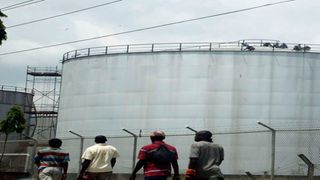
Pedestrians walk past the Kenya Petroleum Refineries Limited in Changamwe, Mombasa.
Business
Premium
Cabinet nod for Kenya Pipeline to buy Sh40bn KPRL raises queries
‘We are working on a story based on the announcement that the Cabinet has approved the acquisition of Kenya Petroleum Refineries Limited (KPRL) by the Kenya Pipeline Company (KPC) and would like to confirm whether the transaction will be based on last year’s government valuation of KPRL of Sh40 billion. Please clarify whether KPC is expected to borrow money from its existing lenders to purchase KPRL.”
That is the question Sunday Nation put to the KPC managing director Joe Sang in a text message.
The response delivered through a spokesman, Andrew Kipkemboi, was cryptic: “We are still awaiting details of what was contained in the Cabinet memo from our parent ministry (Energy and Petroleum), then we will advise accordingly.” That response raised more questions than answers. Is it, really, conceivable that the KPC would not know the details of a transaction of such magnitude that carries such massive implications on its financial health? Or, was it a case of the right hand not knowing what the left is doing? The KPC had chosen to be economical with the truth.
Yet, the fact that KPC is reluctant to give details should not surprise. There is a political subtext to the shenanigans around the proposal. A similar move by the Treasury under former Cabinet secretary Ukur Yatani last year was marred by allegations of irregularities and corruption.
This makes the stakes high for President William Ruto’s administration because the government will not want to project to the public the impression that it is engaging in the very same dodgy dealings the predecessors were perpetrating. With KPC remaining mum on details, speculation about motives behind last week’s Cabinet decision to revive the proposed acquisition is now rife.
The most plausible theory would appear to be that the government is pushing KPC’s acquisition of KPRL because of the pressure on its finances. Having been frozen from international bond markets for more than a year, and with domestic sources of financing becoming more and more expensive, the government is looking for easy sources of money.
Towards the end of President Uhuru Kenyatta’s administration, Mr Yatani had deliberately structured the KPRL acquisition by KPC deal in such a way as to allow the government to deploy KPC’s balance sheet to indirectly access a whopping $400 million loan from a syndicate of KPC’s existing lenders. The Treasury must be finding the arrangement that was structured last year by Mr Yatani alluring because of the speed with which it can be packaged and launched.
Here is a bit of background. On July 15, 2015, the KPC entered into a $350 million facility agreement with six banks – NCBA Bank Kenya, CFC Stanbic, Citibank NA, Kenya Corporative Bank of Kenya, Rand Merchant Bank and Standard Chartered Bank as mandated lead arrangers.
The purpose of the facility was the construction of a ‘20’ diameter pipeline from Mombasa to Nairobi. As of December 2021, the KPC had cleared a substantial part of the loan with the facility now standing at a balance of $150 million.
That large foreign exchange borrowing served to demonstrate that KPC is just but one of the few parastatals that has a healthy balance sheet, reputation, and relationship with lenders to access international debt markets. Towards the end of President Uhuru Kenyatta’s rule, the Treasury crafted a bizarre scheme to irregularly raise billions from banks by forcing KPC to borrow money from its six mandated arrangers to pay for KPRL’s assets, which the Lands ministry had valued at Sh42 billion.
The transaction was structured this way: The government forces a parastatal it owns 100 per cent to borrow billions from a syndicate of banks to purchase another asset that the government also own 100 per cent. Stated differently: You (the government) buy non-revenue generating assets that you already own with borrowed money and then dump a huge liability with third-party banks on the books of KPC.
It begs the question: Where is transparency in a transaction where the government is buying an asset it already owns based on a valuation conducted by itself? Where is arm’s length and how do you buy an asset at a price you have decided by yourself? The clearest indication that the transaction, which the Treasury was trying to force on KPC was dodgy and bizarre was to emerge in a report by the financial services advisory group, PricewaterhouseCoopers Ltd (PwC).
In brief, PwC’s assessment of the transaction was as follows: This asset is yours and KPC can get it for free by transferring the shares at a paper con value. The correspondence shows that the board and management resisted arguing – first, that such a large loan would breach existing covenants with the mandated arrangers; secondly, that there was no feasible business case for KPC to buy KPRL, and thirdly, that such a complex transaction could not be implemented with KPC appointing a transaction adviser.
In a letter dated December 20, 2022, the CEO wrote to Mr Yatani, stating: “The assets deemed useful from a business perspective are valued at Sh19 billion. Other assets valued at Sh22 billion are related to idle refinery assets, which KPC does not need.”
The Treasury would not see KPC’s point. “The purpose of this letter is to grant you approval to borrow a maximum of Sh42 billion ($400 million) and to refinance the existing facility. You may seek term sheets from existing lenders for the $400 million borrowing but extend this to other lenders if the terms are not competitive,” said Mr Yatani.
Whether President Ruto’s administration plans to effect KPC’s acquisition of KPRL on the same terms as crafted by Yatani last year remains to be seen.


